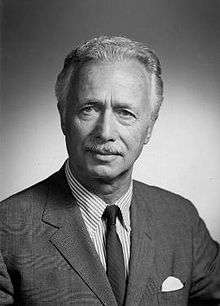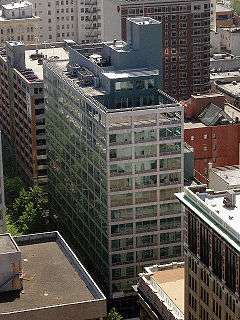Pietro Belluschi
| Pietro Belluschi | |
|---|---|
 | |
| Born |
August 18, 1899 Ancona, Italy |
| Died |
February 14, 1994 (aged 94) Portland, Oregon, United States |
| Nationality |
Italian American |
| Occupation | Architect |
| Awards |
AIA Gold Medal National Medal of Arts |
| Buildings |
Equitable Building Cathedral of Saint Mary of the Assumption |
Pietro Belluschi (August 18, 1899 – February 14, 1994) was an Italian-born American architect, a leader of the Modern Movement in architecture, and was responsible for the design of over 1,000 buildings.[1]
Born in Italy, Belluschi's architectural career began as a draftsman in a Portland, Oregon, firm. He achieved a national reputation within about 20 years, largely for his 1947 aluminum-clad Equitable Building. In 1951 he was named the dean of the MIT School of Architecture and Planning, where he served until 1965, also working as collaborator and design consultant for many high-profile commissions, most famously the 1963 Pan Am Building. He won the 1972 AIA Gold Medal.
Early life
Pietro Belluschi was born in Ancona, Italy, in 1899.[2] He grew up in Italy and served in the Italian armed forces during World War I when Italy was allied with Great Britain, France, and later the United States.[2] Serving in the army he fought against the Austrians at the battles of Caporetto and Vittorio Veneto.[2] After the war, Belluschi studied at the University of Rome, earning a degree in civil engineering in 1922.[1]
He moved to the United States in 1923, despite speaking no English, and finished his education—as an exchange student on a scholarship—at Cornell University with a second degree in civil engineering.[1][2][3] Instead of returning to Italy, he worked briefly as a mining engineer in Idaho earning $5 per day, but he then joined the architectural office of A. E. Doyle in Portland,[2] living in Goose Hollow.[4] He remained in the U.S., as friends in Italy had cautioned him to not return home because of the rise to power of Benito Mussolini and the Fascist government.[2]
Career
At Doyle's office, Belluschi rose rapidly, soon becoming chief designer. After Doyle died in 1928, the firm took him into partnership in 1933. By 1943, Belluschi had assumed control of the firm by buying out all the other partners and was practicing under his own name.
In 1951, Belluschi became Dean of the architecture and planning school at the Massachusetts Institute of Technology, a position he held until 1965.[1] When he accepted the position of dean and moved to Massachusetts, he transferred his office in Portland to the architecture firm Skidmore, Owings and Merrill. The move reduced his annual income from $150,000 to a salary of $15,000, but was prompted by health concerns attributable to the long hours of managing his office while still designing buildings.[2]
Belluschi emerged as a leader in the development of American Modern architecture, with the design of several buildings reflecting the influence of the International Style and his awareness of the technological opportunities of new materials. Most important was the Equitable Building (1944–47) in Portland, Oregon: a concrete frame office block clad in aluminum, and considered the first office building with a completely sealed air-conditioned environment.
Belluschi's churches and residences differed from his commercial works. Although of Modern design, they fit within the development of the Pacific Northwest regional Modern idiom as they frequently used regional materials (particularly wood) and were often integrated with their suburban or rural sites.
Awards and honors
Belluschi was elected a Fellow of the American Academy of Arts and Sciences in 1952.[5] In 1953, he was elected into the National Academy of Design as an Associate member, and became a full member in 1957. He served as a presidential appointee on the U.S. Commission of Fine Arts from 1950 to 1955.[6] He was a Fellow in the American Institute of Architects (AIA), and was awarded the AIA Gold Medal, the highest award given by the institute, in 1972.[1] He was awarded the National Medal of Arts by the National Endowment for the Arts in 1991 for his lifetime achievements.[7] Belluschi was on the jury that selected the winning design for the Vietnam Veterans Memorial in Washington, D.C.[8]
Later life
After leaving MIT in 1965, he continued to work. Belluschi would design and consult on both buildings and issues surrounding urban planning. Pietro Belluschi was married first to Helen Hemmila on December 1, 1934, the mother of his two sons, Peter (b. 1939) and Anthony (b. 1941). After her death in 1962, he married in 1965 Marjorie or Margaret (1920-2009). Pietro Belluschi died in Portland on February 14, 1994.[2]
Works

Belluschi's designs include:
- Pacific Telephone and Telegraph Company Building, southern addition, Portland,[9] 1926
- Pacific Building, Portland, 1926
- Public Service Building, Portland, Oregon, 1927
- Belluschi Building, Portland Art Museum (NRHP), 1932
- Library Building (now Smullin Hall) at Willamette University, Salem, Oregon,[10] 1938
- St. Thomas More Catholic Church, Portland, 1940
- Peter Kerr House, Gearhart, Oregon,[11] 1941
- Chapel, River View Cemetery, Portland, 1942
- Sweeney, Straub and Dimm Printing Plant, Portland (NRHP), 1946
- Emmanuel Lutheran Church, Longview, Washington, 1946
- Burkes House, Portland, 1947
- Oregonian Building, Portland,[9][12] 1947
- Baxter Hall and Collins Hall, Willamette University, Salem, Oregon,[10] 1947
- Psychology Building, Reed College, Portland, 1947–1948
- Equitable Building, Portland (NRHP), 1948
- First Presbyterian Church, Cottage Grove, Oregon (NRHP), 1948
- Percy L. Menefee Ranch House, Yamhill, Oregon, 1948[8]
- Sacred Heart Church, Lake Oswego, Oregon, 1949
- Zion Lutheran Church, Portland (NRHP) (Image), 1950
- Federal Reserve Bank of San Francisco, Portland Branch,[9] 1950
- Central Lutheran Church, Portland,[13] 1951
- St. Philip Neri Catholic Church, Portland, 1952
- YWCA building, Salem,[14] 1954
- Marion County Courthouse, Salem, Oregon,[15] 1954
- Trinity Lutheran Church, Walnut Creek, CA, 1954[16]
- Temple Israel, Swampcott, MA, 1953-1956
- First Lutheran Church, Boston, 1954–1957
- Temple Adath Israel, with Charles Frederick Wise, Merion, Pennsylvania, 1956–1957
- Church of the Redeemer (Baltimore), 1958[17][18]
- Bennington College Library, Bennington, Vermont, 1957–1958
- Central Lutheran Church, Eugene, Oregon,[19] 1959
- Temple B'rith Kodesh, Rochester, New York, 1959–1963
- Goucher College Center, 1960[18][20]
- Trinity Episcopal Church, Concord, Massachusetts, dedicated October 6, 1963
- First Methodist Church, Duluth, Minnesota, 1962–1969
- The Alice Tully Hall at the Juilliard School within the Lincoln Center, New York City, 1963–1969
- Pan Am Building, Belluschi and Walter Gropius as design consultants to Emery Roth & Sons, New York City, 1963
- Rohm and Haas Corporate Headquarters, with George M. Ewing Co., Philadelphia, Pennsylvania, 1964
- Church of the Christian Union, Rockford, Illinois, 1964-1965[21]
- Hoffman Columbia Plaza, now Unitus Plaza, Portland, Oregon, 1966
- Immanuel Lutheran Church, Silverton, Oregon, 1966
- Saint Joseph's Roman Catholic Church, Roseburg, Oregon, 1968[22]
- 555 California Street, as consultant to Wurster, Benardi and Emmons and Skidmore, Owings and Merrill, San Francisco, California, 1969
- One Boston Place, with Emery Roth & Sons, Boston, Massachusetts, 1970
- University of Virginia School of Architecture, 1970
- Woodbrook Baptist Church, 1970[18][23]
- Cathedral of Saint Mary of the Assumption, San Francisco (collaborating with Pier Luigi Nervi and others), 1971
- Clark Art Institute, with The Architects Collaborative, Williamstown, Massachusetts, 1973
- 100 East Pratt Street, with Emery Roth & Sons, Baltimore, Maryland, 1975
- Joseph Meyerhoff Symphony Hall, Baltimore, Maryland, 1978–1982
- Louise M. Davies Symphony Hall, with Skidmore, Owings and Merrill, San Francisco, 1980
- One Financial Center, Boston, 1983
- US Bancorp Tower, as consultant to Skidmore, Owings and Merrill, Portland, 1983
- United Hebrew Congregation, Chesterfield, Missouri, 1986–1989
- Murray Hills Christian Church, Beaverton, Oregon (1987–89)[24]
- Centennial Tower and Wheeler Sports Center, George Fox University[25][26] 1991
- Breitenbush Hall, Oregon State Hospital, Salem (NRHP)[9]
- Portsmouth Abbey School campus, Portsmouth, Rhode Island. Belluschi designed 14 of the 27 buildings on campus between 1960 and 1991.
- Uncle Toby's Story House (1932), Blue Wing Lodge (1936), Guardians' Lodge (1929), Kiwanis Lodge (1931), Camp Namanu, Sandy, Oregon All being restored and updated as of 2010.
- Lacamas Summer Home, Camas, Washington
- Chapel of Christ the Teacher, University of Portland[27]
References
- 1 2 3 4 5 Belluschi, Pietro. (2007). In Encyclopædia Britannica. Retrieved September 22, 2007, from: Encyclopædia Britannica Online
- 1 2 3 4 5 6 7 8 Gragg, Randy. "Belluschi revered as creative, 'spiritual' architect". The Oregonian, February 15, 1994.
- ↑ Birkland, Dave (February 16, 1994). "Pietro Belluschi, 94, Helped Design Seattle Convention Center". Seattle Times. Retrieved 2008-07-01.
- ↑ Prince, Tracy J. (2011). Portland's Goose Hollow. Charleston, South Carolina: Arcadia Publishing. p. 125. ISBN 978-0-7385-7472-1.
- ↑ "Book of Members, 1780-2010: Chapter B" (PDF). American Academy of Arts and Sciences. Retrieved May 30, 2011.
- ↑ Thomas E. Luebke, ed., Civic Art: A Centennial History of the U.S. Commission of Fine Arts (Washington, D.C.: U.S. Commission of Fine Arts, 2013): Appendix B, p. 540.
- ↑ National Medal of Arts: Medalists. National Endowment for the Arts, accessed September 22, 2007.
- 1 2 Clausen, Meredith L., Pietro Belluschi: Modern American Architect, MIT Press, Cambridge, Massachusetts and London 1994, ISBN 0-262-03220-1
- 1 2 3 4 Architects Associated with Oregon State Hospital
- 1 2 Gregg, Robert D. 1970. Chronicles of Willamette, volume II: Those eventful years of the President Smith era. Salem, Or: Willamette University.
- ↑ http://www.greatbuildings.com/buildings/Peter_Kerr_House.html
- ↑ MacColl, E. Kimbark (1979). The Growth of a City: Power and Politics in Portland, Oregon 1915-1950. Portland, Oregon: The Georgian Press. ISBN 0-9603408-1-5.
- ↑ Central Lutheran Church: Building History
- ↑ Salem Online History, The YWCA: Celebrating 90 Years in Salem
- ↑ Marion County Circuit Court:The Marion County Courthouse: A Historical Perspective
- ↑ http://nwda.orbiscascade.org/ark:/80444/xv64644
- ↑ A Guide To Baltimore Architecture, Third Edition, Dorsey & Dilts, 1997 ISBN 0-87033-477-8, pg. 333-334
- 1 2 3 "Raising Baltimore's Skyline" Gunts, Edward. The Sun [Baltimore, Md] 27 Dec 1987: T11.
- ↑ University of Oregon News release: "UO Gallery Shows Drawings by Pietro Belluschi
- ↑ A Guide To Baltimore Architecture, Third Edition, Dorsey & Dilts, 1997 ISBN 0-87033-477-8, pg. 347
- ↑ The Unitarian Universalist Church
- ↑ "Saint Joseph's Roman Catholic Church (Roseburg, Oregon)". Building Oregon. Retrieved September 17, 2016.
- ↑ "Finally Looking Like A Church", Gunts, Edward. The Sun [Baltimore, Md] 02 Jan 1997: 2B.
- ↑ Clausen, Meredith L. Spiritual Space: The Religious Architecture of Pietro Belluschi, University of Washington Press; First Edition, August 1992.
- ↑ George Fox University: Centennial Clock Tower,
- ↑ George Fox University Athletic Facilities, Newberg, Ore.
- ↑ University of Portland: Campus Ministry: Prayer Schedule
External links
| Wikimedia Commons has media related to Pietro Belluschi. |
- Oregon Blue Book biography
- 1983 interview from the Smithsonian's Archives of American Art
- Photographs of Pietro Belluschi's works from the Phyllis and Robert Massar Photograph Collection of Pacific Northwest Architecture - University of Washington Digital Collections

